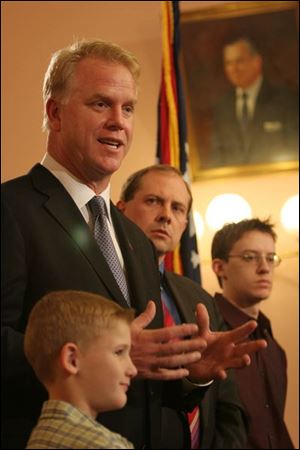
Ex-Bengal Esiason opts to make play to help ill children
3/9/2005
Boomer Esiason speaks against funding cuts for the Bureau of Children with Medical Handicaps. With him at the Statehouse yesterday are, from left, Tanner Stainbrook, 9, of Ottawa, Sen. Jay Hottinger of Newark, and Pat McGuiness, 23, of Akron.
COLUMBUS - Former Cincinnati Bengals quarterback Boomer Esiason yesterday sought to score against Gov. Bob Taft's budget proposal, trying to thwart a planned cut in a program treating children with severe medical handicaps.
Mr. Esiason, whose 13-year-old son was diagnosed with cystic fibrosis at the age of 2, is not only going for a touchdown by trying to stop this cut but is seeking a two-point conversion by trying to roll back past cuts.
"From a political standpoint, this is very small population," the CBS football commentator said. "There aren't a lot of votes associated with it. You can understand why this might be an attractive thing to cut out of a particular state budget. But when you really sit down and logically look at it, you're looking at kids who need help.●.●.," he said. "If government doesn't do that, then what is government all about?"
n 1998, the Ohio Department of Health's Bureau of Children with Medical Handicaps spent $12 million a year providing treatment and drugs for roughly 25,000 children with severe chronic conditions, including hemophilia and cystic fibrosis. Cystic fibrosis is a relatively rare and incurable genetic disorder characterized by abnormal mucus secretions that obstruct the lungs and pancreas.
This year the program has been cut to $6 million, serving about 18,000, and the department has proposed cutting it by $1 million more in the next two-year budget taking effect July 1.
Tanner Stainbrook, 9, of Ottawa, was affected by last year's cut. His parents, Gary and Wendy, earn a total of $50,000 a year, although Tanner's annual bills for drugs, therapy, and other treatment can reach as high as $70,000.
They have private health insurance that covers most of the bills, but they relied on the state program to help them cover their co-payments. As a result of eligibility changes enacted last year, the state now demands the Stainbrooks pay $6,000 a year before it will step in, money Mrs. Stainbrook said the family of five doesn't have. "I will do whatever it takes to make sure that [Tanner] gets what he needs," Mrs. Stainbrook said. "If that means quitting my job, filing bankruptcy, or getting a legal separation, by God, I'll do it."
The department said it has not decided how it will find the additional $1 million in savings in the program, although it said it will look at other options before again reducing eligibility. That may mean caps on how much patients may spend on particular services.
"The department has gone through something like a 26 percent reduction since 2000 in our overall [general revenue fund] budget .●.●.," spokesman Lee Yoakum said. "We believe the primary mission of public health is on prevention. For every dollar spent on prevention, we save $14 on treatment."
Three majority Republican lawmakers, who joined Mr. Esiason at a press conference, said they will seek full restoration of the program. "We're looking at only $12 million out of a $51 billion budget," Sen. Jay Hottinger (R., Newark) said. "You're literally talking about pennies on the dollar."
Contact Jim Provance at:
jprovance@theblade.com or
614-221-0496.